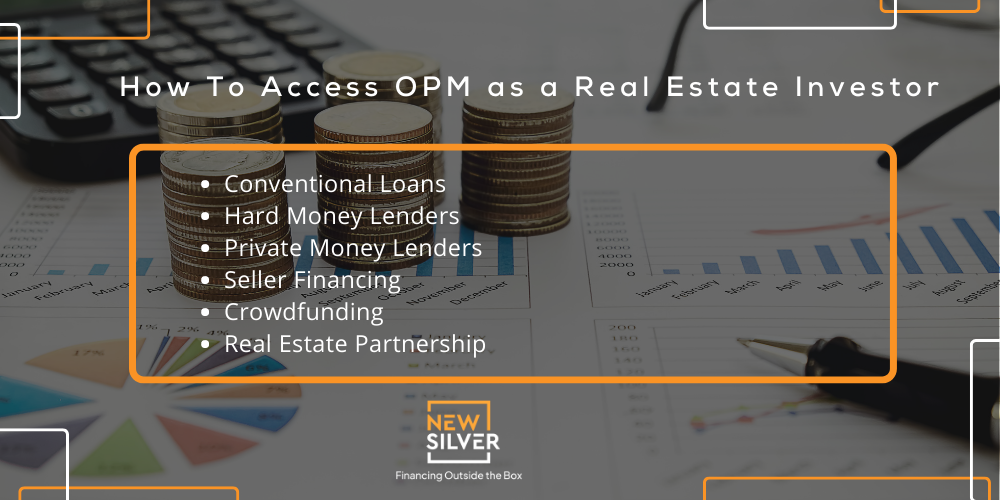A brief outline
Taking the first step onto the real estate ladder can be difficult. Luckily, there are a variety of financing options available to real estate investors which include using Other People’s Money (OPM). This can be a successful way to invest in real estate and generate big profits. Here’s how OPM in real estate works.
Table of Contents

One of the biggest attractions to real estate investing is the fact that you don’t need to have hundreds of thousands of dollars to get started. For the average American, the idea of getting into the real estate game may be intimidating because investment properties are often hundreds of thousands, if not millions of dollars, and they more than likely don’t have enough of their own money.
The good news is, there are a variety of options that don’t include saving up all the money yourself. Let’s take a closer look at what OPM in real estate means, and how this can be a game changer for those wanting to invest.
What Is OPM in Real Estate Investing?

OPM, or other people’s money, is a popular way to finance real estate investing. By using OPM, investors can purchase real estate without using any of their own funds. There are a number of ways to find OPM, such as through private lenders, family and friends, or hard money lenders.
Other people’s money can be a great way to get started in real estate investing, but it’s important to be aware of the risks involved. OPM can be more expensive than traditional financing, and there is the potential that the deal will fall through, and the investor will lose all of their money.
For those willing to take on the risk, OPM can be a great way to get started in real estate investing. This can be particularly appealing for new investors who don’t have the funds or the credit available. It can also be very useful for investors who can’t qualify for a conventional loan. OPM is a great way to increase the return on investment because investors use it grow their real estate portfolios with a lower risk.
How To Access OPM as a Real Estate Investor
Real estate investors who choose to use other people’s money to finance their investing journey have various options to choose from. It’s a good idea to consider each option before deciding on one that best suits your unique investing situation.

• Conventional Loans
A common way to finance investment properties is to use conventional loans which are supplied by various entities, including private lenders and the likes of Fannie Mae or Freddie Mac. These are long-term loans with lower interest rates however the lending criteria can be more stringent. Conventional loans simply refer to loans that are not part of a particular government program.
Borrowers need to complete an application in which there will be information and documents required. These include the investors’ credit score, credit history, proof of income, employment verification, and more. Not everyone can qualify for these, so some investors will choose to go another route that is easier to qualify for.
• Hard Money Lenders
Hard money lenders provide loans for real estate investors for fix and flip projects, rental properties and construction projects. These may come with higher interest rates but qualifying for hard money loans is easier than conventional loans. These loans are asset-based, so the property itself is used as collateral.
Hard money loans are provided by private lenders who can offer more flexible loan terms. Hard money loans are usually used for fix and flip projects as they’re often short-term, with interest-only payments and a balloon payment at the end of the loan terms.
• Private Money Lenders
Using a private money lender such as a friend, family member or someone in your professional network is another way to leverage other people’s money to finance an investment property purchase. Self-directed retirement accounts are also a private money source for real estate investing.
The advantage of using a private money loan is that the loan terms will be flexible and there isn’t likely to be difficult qualification criteria as there are no federal regulations. Private money lenders can also take on the responsibility of the purchase, and help new investors get a foot in the door if they have no experience and a low credit score.
• Seller Financing
This is a less common, but effective strategy for investors who wish to use other people’s money to finance their investment property purchase. In this scenario, the property seller will effectively become the lender as well. The seller will provide the buyer with financing for the property and allow them to repay the loan back over time.
This requires a promissory note, which outlines the terms of the deal and indicates how much the buyer owes the seller. Should the buyer default on their payments, the seller can repossess the house. There is typically a fixed interest rate on these loans.
• Crowdfunding
A creative financing method for funding investment property purchases is through crowdfunding. This entails using a crowdfunding platform online to display the deal and explaining the details of the investing strategy. From there, others on the platform can collectively contribute towards the deal.
Crowdfunding allows investors to reach more people, in a convenient way. Crowdfunding platforms are streamlined, and the entire transaction can be done through these platforms, from displaying the deal information to the funds transfer.
• Real Estate Partnership
Forming a real estate partnership involves finding business partners or other investors who would like to fund the deal. These can be equity partners who provide the capital, while you find the deal. Finding a partner to invest shouldn’t be all that difficult because investors are often willing to fund real estate deals.
Many investors want to get into real estate more but simply don’t have the time or capacity, so this can be a great way to help them and help yourself. In return, you’ll need to provide them with a portion of the returns from the property, or repay them later on, depending on the deal you’ve made.
What Is Robert Kiyosaki’s Approach to Using OPM To Buy Real Estate?

Robert Kiyosaki teaches that the idea that a property is an asset is a myth. He states that cash flow is the key element to real estate investing, and property appreciation is not something to rely on. Kiyosaki teaches that investors should make money on the purchase of a property, instead of the sale of it. They can do this by choosing a deal that will provide a positive cash flow for the future.
Kiyosaki refers to using OPM in real estate as “good debt”. His theory is that “bad debt” is anything that is costing you money out of pocket. For example, a mortgage on a primary residence or a credit card. Whereas “good debt” can put money back into your pocket. As such, his teachings state that investors should use as little of their own money as possible, and instead rely on OPM.
Kiyosaki suggests the following options for OPM:
- Banks
- Private lenders
- Seller financing
- Investors
- Government tax credits
- Cash flow on operations
Kiyosaki believes that the best way for real estate investors to be successful is to spend their time finding great deals, and then find others to invest in the deals. Kiyosaki says that when the deal is structured correctly, this will allow investors to gain a profit generating asset for very little. He outlines the following process as a good example:
Step 1: Find a real estate deal that can provide good returns in the future, even if this means increasing the NOI somehow.
Step 2: Create a solid business plan and find investors who would like to fund the property purchase.
Step 3: Once the property has increased in value, refinance it, pay back the investors and retain ownership of the property as it continues to generate a profit.
Can You Fund Real Estate Deals Without Using Other People’s Money?
Funding real estate deals without using OPM is possible through various methods. Let’s take a quick look at some of these…

Paying Cash
Saving up enough cash to pay for an investment property is certainly not something everyone is capable of doing. However, if you have the means, paying cash for an investment property can guarantee you a better deal. Sellers often give cash buyers preference, and even a better price because the funds are guaranteed and can be paid quickly.
This method allows you to save money in the long run as you won’t have to pay back a loan with interest. It also leads to a quicker process as the funds are available upfront, and investors can beat the competition.
Tapping Into Your Home Equity
If you’ve built up equity in a property already you can tap into this using a home equity loan to finance the purchase of another property. This means you’ll be using your own money and taking out a larger loan that will encompass the extra amount that you need. These loans are easier to qualify for as they are secured by the property you already have.
You can also refinance your home or use a HELOC (home equity line of credit) to tap into your existing equity. This is a more affordable way to fund the purchase of an investment property. Make sure that you can repay the loan however, as defaulting on this will result in foreclosure.
Retirement accounts
Another way to use your own money to fund the purchase of a real estate deal is to tap into your 401(k) or other retirement accounts. Remember, this needs to be done in a very planned and careful manner, as the risk is high. There may be fees charged, but any interest on this will go back into your 401(k).
Final Thoughts – Which Approach Is Best for You?
Deciding on the right financing approach depends entirely on your unique situation. When it comes to using OPM, we can offer 3 tips. First, it’s important to partner with a lender or investors who understand your goals and are willing to work with you. Second, make sure that you are comfortable with the terms of the loan and that they fit within your overall investment plan. Finally, always consult with an experienced real estate professional to get the most out of the deal and ensure a smooth transaction.



